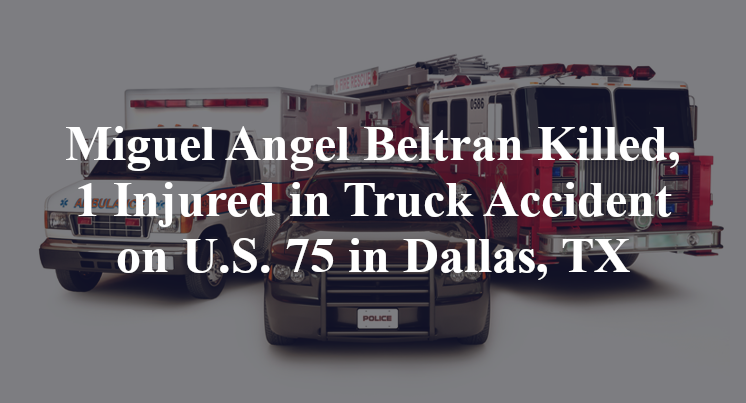Miguel Angel Beltran Killed, 1 Injured in Truck Accident on U.S. 75 in Dallas, TX
UPDATE (June 3, 2025): Recent reports have been released which clarify the fact that a 30-year-old woman was also in the passenger vehicle along with Beltran; she reportedly sustained serious injuries as a result of the wreck, as well. No additional details are currently available. Investigations continue.
Dallas, TX — May 12, 2025, Miguel Beltran was killed in a truck accident shortly before 1:00 a.m. along U.S. Highway 75.
According to authorities, 30-year-old Miguel Angel Beltran was traveling northbound passenger car on U.S. 75 in at Caruth Haven Lane when the accident took place.

Officials indicate that there was a truck applying road paint with a traffic attenuation truck behind it in the area at the time of the wreck. Reports state that, for as yet unknown reasons, the rear-end of the attenuation truck was struck by the passenger vehicle. The impact reportedly caused the passenger vehicle to lose control and collide with a guardrail.
Beltran suffered fatal injuries over the course of the accident, reports state, and was declared deceased at the scene. Additional details pertaining to this incident are not available at this point in time. The investigation is currently ongoing.
Commentary by Attorney Michael Grossman
When crashes like this happen—where a passenger vehicle collides with a work zone vehicle during overnight maintenance—it raises questions that go far beyond driver attentiveness. Roadwork, especially in the early morning hours, presents unique risks that must be carefully managed. To understand what led to the loss of Miguel Beltran’s life on U.S. Highway 75, it’s important to begin by asking three critical questions.
First, did investigators thoroughly evaluate the layout and visibility of the work zone at the time of the crash? Work zones on highways, particularly those involving slow-moving or stationary equipment, must be clearly marked with warning signs, lighting, and proper spacing to allow drivers time to adjust. Was there adequate advanced signage alerting motorists to the presence of the painting crew and the attenuation truck? Were lighting and reflectivity sufficient for nighttime visibility? If these precautions weren’t in place or failed to account for the driving environment at 1:00 a.m., the risk to drivers increases dramatically.
Second, has anyone considered whether a mechanical issue contributed to the crash? If Mr. Beltran’s vehicle experienced a steering or brake failure, he may not have been able to avoid the collision even if he was fully alert. Similarly, if the attenuation truck’s lighting or warning systems were malfunctioning, that could have made it difficult for approaching traffic to distinguish the vehicle in time. These are questions that require a forensic inspection of both vehicles—especially the lighting, brake systems, and onboard safety features—before any repairs or disposal take place.
Finally, has all available electronic and digital data been preserved and reviewed? Most passenger vehicles and commercial trucks are equipped with event data recorders that capture vehicle speed, braking, throttle position, and steering input in the moments leading up to a crash. That data can help determine whether Mr. Beltran tried to avoid the collision, how quickly he was traveling, and whether the vehicle responded appropriately. Investigators should also check for dashcam footage, GPS logs, and any available traffic camera recordings that can confirm how the crash unfolded.
Answering these three questions is critical to making sure that no stone is left unturned in understanding the causes of a crash like this. Serious wrecks deserve serious investigation, not assumptions. Getting clear answers to these questions is crucial for those seeking to understand what happened and why—and it's the least that can be done to help those affected find the clarity and closure they deserve.

“These are essential reads for anyone dealing with the aftermath of a truck wreck”– Attorney Cory Carlson